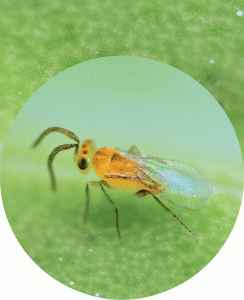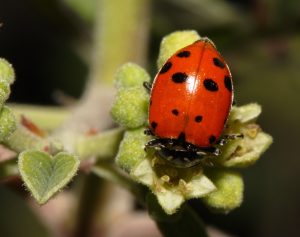Fauna: Beneficial insects for cultivated plants
Welcome to this section where you can find relevant information about animals that are part of the landscapes.
In this first edition, the Biologist Manuel Lara presents two beneficial insects for cultivated plants: Eretmocerus eremicus, a parasitic wasp that is commercialized as biological control against the whitefly in greenhouses, and the convergent lady beetle (Hippodamia convergens) which we can find naturally in the garden, being an excellent aid for controlling plant’s pests.

Photography: Entocare Wageningen
ERETMOCERUS EREMICUS
Eretmocerus eremicus
Family: Aphelinidae.
Biological control of: various species of whitefly, (Homoptera: Aleyrodidae).
The females of this species of parasitic wasp lay their eggs between the whitefly nymphs and the affected plant surface. When it hatches, the larva makes a hole in the nymph, penetrating it and remaining dormant while emanating digestive enzymes to feed from the liquid part of its host. When the wasp matures, it makes another hole in the nymph to emerge as an adult, killing it in the process.
__________

Catarina – mariquita (Ladybug – ladybird)
Hippodamia convergens Guérin-Méneville
Family: Coccinellidae
Biological control of: various species of Aphids, (Hemiptera: Aphididae).
The main nourishment of this kind of bug are the different species of Aphids, although they depred also mites, cocoids, thrips, the eggs or diverse insects at their immature stages, hunting this preys during all their life cycle, from larval stage until adulthood.
The ladybug larvae are active depredators, as soon they hatch they begin to search small insects. Eventually, when the animal food is scarce, they start to feed from spores and vegetal material.








